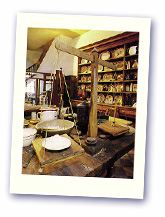 |
Search the site:

Newbridge House, County DublinOther rooms in the main building include the library, with its baroque ceiling depicting the four seasons, and the 'Mr Cobbe's Museum or Cabinet of Curiosities' - a curio room dating from 1790 and containing a remarkable display of souvenirs and trophies collected by various members of the family on their numerous travels abroad, particularly in India. The cabinets are original, as is the attractive and recently restored wallcover above, made of bamboo and Chinese paper.
From the museum visitors proceed into the middle hall which forms the north-west corner of the old house. An arch in the end wall guides the eye through a narrow vestibule to the richly modelled pedimented doorcase framing the door of the red drawing-room, which was added by the archbishop's The room was redecorated in 1828 and still retains its carpet crimson flock wallpaper and curtains, the latter made by the Dublin firm Mack, Williams and Gibton who also supplied much of the room's furniture. The walls have no less than forty-five pictures, many bought on the advice of the art connoisseur Matthew Pilkington, Vicar of Donabate. Pilkington was a friend of Cobbe's and is best remembered for his spectacular divorce suit with his wife, the amusing and naughty Laetitia, who was described by Virginia Woolf in an essay as 'shady shifting and adventurous'. Mrs Pilkington's autobiography is on display in one of the glass cases in the house. The servants' rooms in the basement and yard have also survived intact and have been admirably restored in recent years. The kitchen is fitted with its original screen wall, dresser with jugs and dishes, mid nineteenth-century iron range, whiskey still, duck press, rat traps, numerous copper pots, jelly moulds and wooden tub for salting meat. In the adjacent laundry visitors can inspect a range of equipment used to wash, dry, iron and mend clothes. In the cobbled yard lies the dairy with its marble niches for maturing cheeses, the demesne workers' kitchen, a forge and a carpenter's shop. On display in the coach house is the state carriage made in London in 1790 for 'Black Jack' FitzGibbon, the Lord Chancellor of Ireland and a relation of the Cobbes. The coach was itself black until restored by the National Museum to its former gold magnificence - even the fresco panels had been painted out, probably for the funeral of Queen Victoria.
Located on the western edge of Donabate, 11 miles north of Dublin on the N1. From the Appletree Press title: Irish Country Houses.
|
All Material © 1999-2005 Irelandseye.com and contributors

 son after 1765. This is a vast room, 42.9 feet by 25.6 feet with a bowed window looking out onto the gardens and an elaborate rococo ceiling and coved cornice by Richard William, a pupil of the great stuccodore Robert West.
son after 1765. This is a vast room, 42.9 feet by 25.6 feet with a bowed window looking out onto the gardens and an elaborate rococo ceiling and coved cornice by Richard William, a pupil of the great stuccodore Robert West.